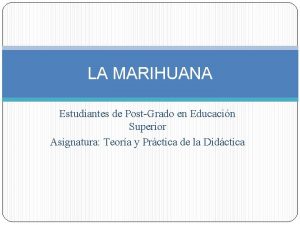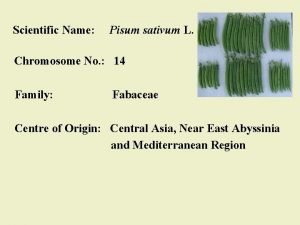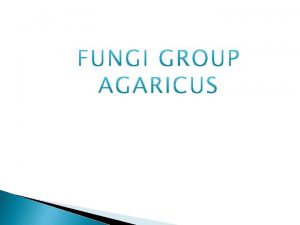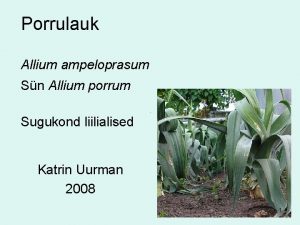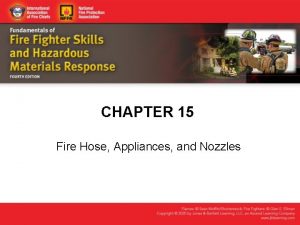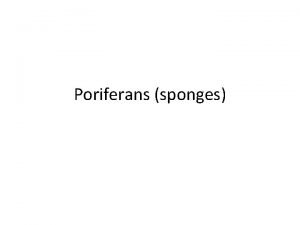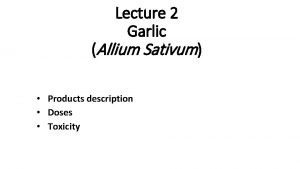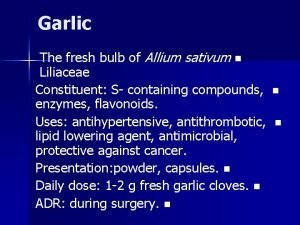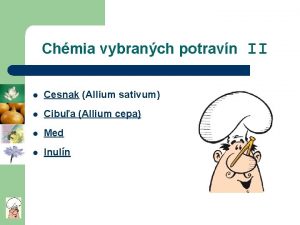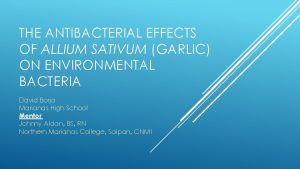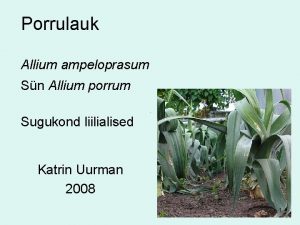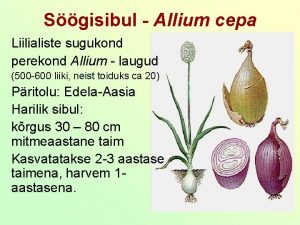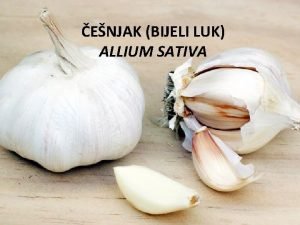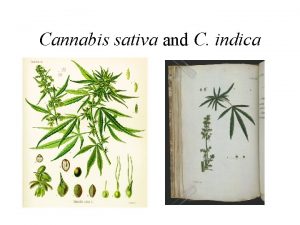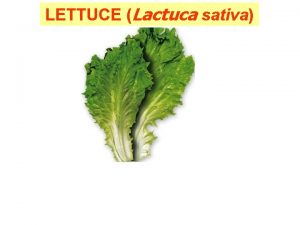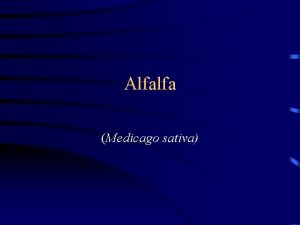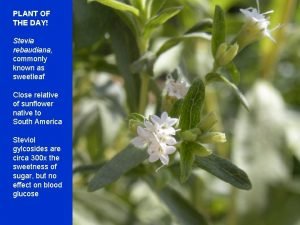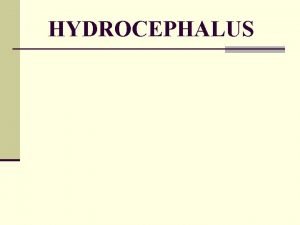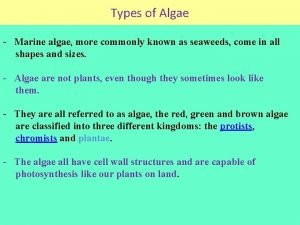ALLIUM SATIVA DESCRIPTION Allium sativum commonly known as



























- Slides: 27

ALLIUM SATIVA

DESCRIPTION �Allium sativum, commonly known as garlic, is a species in the onion family Alliaceae �Allium sativum is a bulbous plant. It grows up to 1. 2 m (4 ft) in height. It is pollinated by bees and other insects.

Origin and major types �Allium sativum grows in the wild in areas where it has become naturalized. �The "wild garlic", "crow garlic", and "field garlic" of Britain are members of the species Allium ursinum, Allium vineale, and Allium oleraceum, respectively.

Historical use �The use of garlic in China dates back thousands of years. It was consumed by ancient Greek and Roman soldiers, sailors, and rural classes. � Alexander Neckam, a writer of the 12 th century discussed it as a palliative for the heat of the sun in field labor. Garlic was placed by the ancient Greeks on the piles of stones at crossroads, as a supper for Hecate.

�In the 17 th century Dr Thomas Sydenham valued it as an application in confluent smallpox, and William Cullen's Materia Medica of 1789 found some dropsies cured by it alone. �Garlic was rare in traditional English cuisine and has been a much more common ingredient in Mediterranean Europe. � Garlic was used as an antiseptic to prevent gangrene during World Wars I and II.

RESEARCH Cardiovascular � A great deal of low quality clinical research has been conducted to determine the effect of garlic on preventing cardiovascular diseases and on various biomarkers of cardiovascular health, but as of 2015, the results were contradictory and it was not known if there any effects. � A 2016 meta-analysis indicated there was no effect of garlic consumption on blood levels of lipoprotein, a marker of atherosclerosis. Because garlic might reduce platelet aggregation, people taking anticoagulant medication are cautioned about consuming garlic.

CANCER �A 2016 meta-analysis of case- control and cohort studies found a moderate inverse association between garlic intake and some cancers of the upper digestive tract. �A 2016 meta-analysis found no effect of garlic on colorectal cancer. � A 2014 meta-analysis found garlic supplements or allium vegetables to have no effect on colorectal cancers.

Adverse effects and toxicology � Garlic is known to cause bad breath (halitosis) and body odor, described as a pungent "garlicky" smell to sweat. This is caused by allyl methyl sulfide(AMS). � AMS is a volatile liquid which is absorbed into the blood during the metabolism of garlic-derived sulfur compounds; from the blood it travels to the lungs and skin, where it is exuded through skin pores. Washing the skin with soap is only a partial and imperfect solution to the smell. � Studies have shown sipping milk at the same time as consuming garlic can significantly neutralize bad breath. Mixing garlic with milk in the mouth before swallowing reduced the odor better than drinking milk afterward. Plain water, mushrooms and basil may also reduce the odor; the mix of fat and water found in milk, however, was the most effective.

Spiritual and religious uses �In myths, garlic has been regarded as a force for both good and evil. �In Europe, many cultures have used garlic for protection or white magic. � Central European folk beliefs considered garlic a powerful ward against demons, werewolves, and vampires. To ward off vampires, garlic could be worn, hung in windows, or rubbed on chimneys and keyholes. �In both Hinduism and Jainism, garlic is thought to stimulate and warm the body and to increase one's desires

MIND �Weak memory. �Lack of ideas. �Desire to escape. �Sadness when alone ; moral uneasiness �Afraid of never getting well �Fear of not being able to bear any kind of medicine ; fear of being poisoned ; sensitiveness ; impatience. �Cannot bear anything ; wants many things and is not pleased with any ; every afternoon.

HEAD �Heaviness in head : in forehead, can hardly open eyes ; with mucus in throat ; ceases with onset of menses, and returns afterwards. �Pulsations in temples. �Dull pain in occiput in morning when lying on back. �Pressing pains from within outward.

EYES �Could read only with spectacles ; heaviness in eyes. �Catarrhal ophthalmia at night ; smarting, burning, lachrymation ; eyelids agglutinated ; returns every night when he tries to read. �Irritation of eyes. �Profuse watering of eyes without coryza.

EARS �Deafness of left ear (catarrhal). �Hardened earwax (topically with milk). �Hardened crusts in outer canal. �He heard better in diseased ear.

NOSE �Increased secretion of nasal mucus, with slight stoppage of both nostrils. �Coryza more dry than fluent, with pressive pain from above root of nose. �Smarting at junction of ala and face, mostly left.

TONGUE • Taste : hot, as from throat, causing increase of saliva. �Tongue furred white, with a disagreeable taste. �Tongue dry at night

STOMACH �Heartburn. �Pressure as from a stone. �Long-standing dyspepsia, especially in old, fleshy people, whose bowels are disturbed by slightest deviation from a regular diet. �In forenoon, pressure in epigastrium and transverse colon, had to sit bent forward and press with hands. �Pain under short ribs, back, right side.

ABDOMEN �Pain in region of descending colon, just below ribs. �Violent burning in abdomen; Wind-colic. �Everything (in abdomen) seems to drag downward. �Every step on pavement caused excruciating pain, as if intestines would be torn apart ; > by lying down.

STOOLS AND RECTUM �Expels flatus. �Stools at first fecal, then watery and hot. �Looseness of bowels. �Constipation with almost constant dull pains in bowels. �Normal stool immediately after a meal. �Prolapsus ani. �Expels worms.

URINARY ORGANS �Pain in region of kidneys. �Bladder distended, could bear no pressure ; continual urging to urinate with passing of a few drops. �Ulceration of bladder, caused by calculi. �Urine whitish, abundant, becomes cloudy from nitric acid. �Urine increased, or lessened in quantity. �Urine dark brown with copious sediment.

FEMALE SEXUAL ORGANS �Menses too early ; headache and dizziness lessen as flow becomes established. �Soreness of vulva and thighs during menstrual flow. �Pustules on vulva during menses. �Bright red spots, with itching and smarting on inside of labia majora and at vulva.

RESPIRATORY SYSTEM �Chronic cough, dyspnoea ; ropy sputum. �Cough hollow, dry, not very frequent. �Morning cough, after leaving his bed- room, with extremely copious mucous expectoration. �Cough which seems to come from stomach. �Dry cough after eating.

�Cough which gives rise to a fetid smell. �Sudden paroxysm of hard dry cough while smoking, obliging him to quit. �Expectoration of a thin, yellowish, purulent-looking, blood streaked mucus, of a putrid odor. �Great difficulty in expectorating a glutinous mucus

EXTREMITY � Red spots on hands. � Skin peels off the hand. � Dry heat on back of hands ; slight moisture of palms. � Rheumatism of hips. � Tearing pain in hip. � Intolerable pain confined to common tendon of iliac and psoas muscles ; < from least movement ; extorts cries when he tries to cross his limbs ; no pain if he lifts leg gently with hand ; < 8 P. M. in bed, cannot then change his position or sleep. � Pains in limbs < from changes of temperature and under influence of moist heat.

�Weakness of legs ; worse at knees. �Legs do not grow as rapidly as rest of body. �Pain as from a sprain in ankle joint. �Tearing pain in feet. �Sensation of stiffness in feet. �Toe joints pain as if sprained. �Burning in soles.

FEVER �Chilliness and heat alternate, more evenings ; acrid sweat causing itching ; hard pulse. �Cold at night in bed. �Vomiting during fever. �Sweat acrid, offensive. �Sweat in afternoon.

SKIN �Skin sensitive ; dry �Swelling with itching and burning. �Herpetic, itching, burning, red or whitish spots on a swollen surface.

RELATIONS �Similar to : Bryon. ; Capsic. (asthma, fetid breath with cough) ; Coloc. (colic, hip-pain) ; Ignat. ; Lycop. ; Nux vom. and Senega. �Not following well : Aloes, All cep. , Scilla. �Complementary to Arsen. , especially in catarrh, asthma and effects of overexertion. �Antidote to Allium sat. : Lycop.
 Garlic chromosome number
Garlic chromosome number Sativa originaria de las cordilleras del himalaya
Sativa originaria de las cordilleras del himalaya Cabanis sativa
Cabanis sativa Ordem fabales
Ordem fabales Tendrometer
Tendrometer Agaricus commonly known as
Agaricus commonly known as What are optical storage devices are most commonly known as
What are optical storage devices are most commonly known as Allium cepa habitat
Allium cepa habitat Allium nevskianum
Allium nevskianum Allium ampeloprasum
Allium ampeloprasum A pneumatic drill is commonly used
A pneumatic drill is commonly used Alcohol is the most commonly used drug in our society
Alcohol is the most commonly used drug in our society Sodium hydroxide relaxers are commonly called
Sodium hydroxide relaxers are commonly called Methods are commonly used to
Methods are commonly used to Commonly misused homonyms
Commonly misused homonyms 5.9 commonly fingerspelled words
5.9 commonly fingerspelled words 3 components of narrative paragraph
3 components of narrative paragraph Chapter 15 fire hose appliances and nozzles
Chapter 15 fire hose appliances and nozzles Computer graphics models are now commonly used for making ?
Computer graphics models are now commonly used for making ? Poriferans are commonly referred to as
Poriferans are commonly referred to as Site:slidetodoc.com
Site:slidetodoc.com Effected vs affected
Effected vs affected A commonly cited hazard for stairways and or ladders is
A commonly cited hazard for stairways and or ladders is A commonly cited hazard for stairways and/or ladders is:
A commonly cited hazard for stairways and/or ladders is: Altered cognition in older adults is commonly attributed to
Altered cognition in older adults is commonly attributed to What is a thio relaxer
What is a thio relaxer Hodgepodge jeopardy
Hodgepodge jeopardy A website is a collection of what
A website is a collection of what

